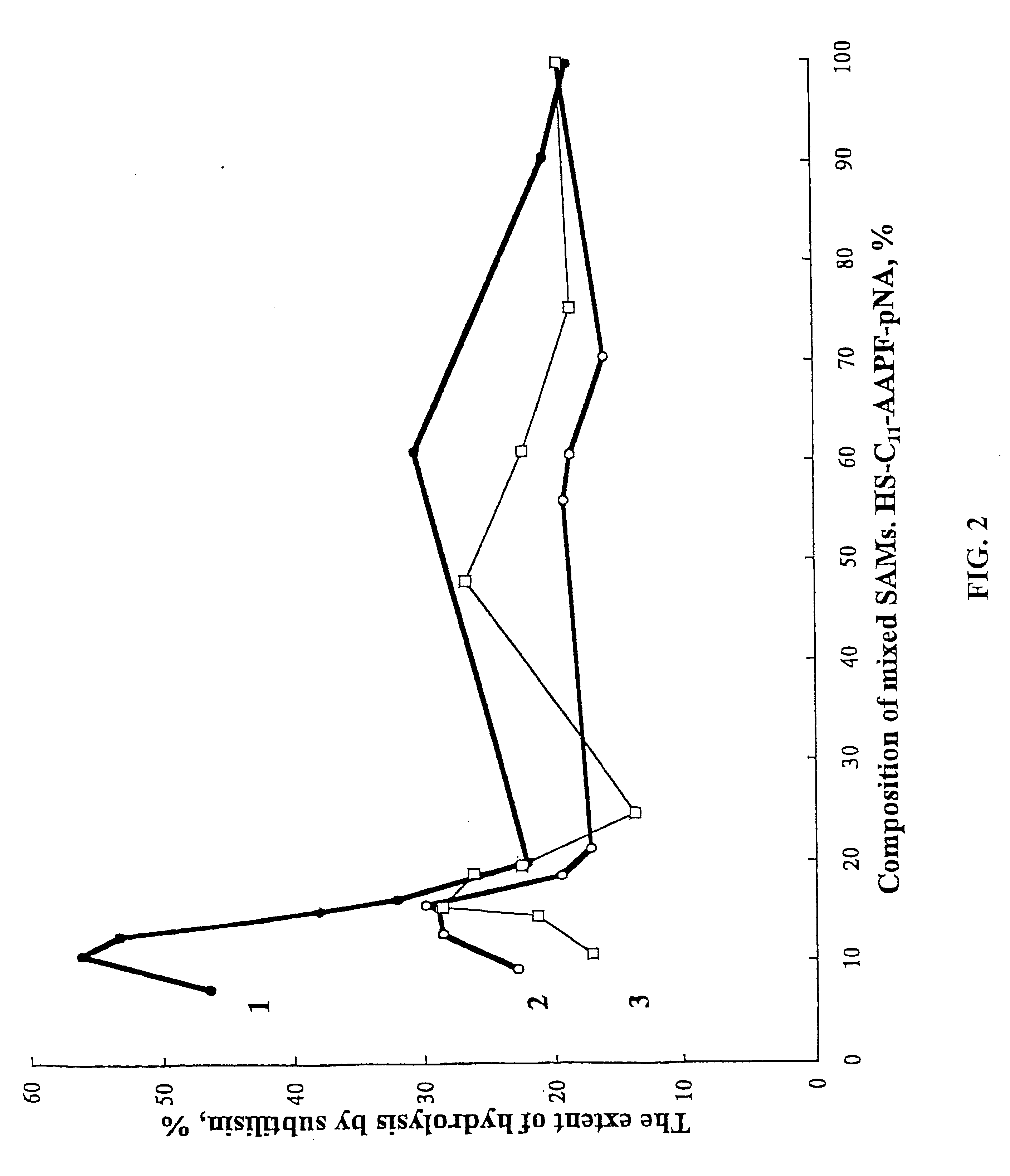Support for high performance affinity chromatography and other uses
a technology of affinity chromatography and support, which is applied in the field of support for high-performance affinity chromatography and other uses, can solve the problems of insufficient size of colloidal particles (up to 10 nm in size) and inability to pack (unsupported) in columns, and achieves the effect of not being able to use larger gold particles
- Summary
- Abstract
- Description
- Claims
- Application Information
AI Technical Summary
Benefits of technology
Problems solved by technology
Method used
Image
Examples
example 1
Example 1 illustrates the procedure utilized to deposit electroless gold onto a silica substrate.
1.1 Materials
Electroless gold was prepared from an aqueous solution of Na.sub.3 Au(SO.sub.3).sub.2 purchased from Technic, Inc. Silica gel (50-200 mesh, particle sizes ranging from 50 to 200 .mu.m, surface area of 300-500 m.sup.2 / g, pore volume between 0.75 cm.sup.3 / g and 1.2 cm.sup.3 / g, and pore diameters between 60 .ANG. and 150 .ANG.) was purchased from Aldrich.
1.2 Deposition of Electroless Gold
The experimental procedure used to coat the silica gel with gold was adapted from methods reported in the past for electroless deposition of gold onto polymeric membranes for filtration (Menon, V.P. et al., Anal Chem 67:1920 (1995)). A sample of silica gel was treated with "piranha solution" (70% H.sub.2 SO.sub.4, 30% H.sub.2 O.sub.2 ; Caution: "piranha solution" reacts violently with organic materials), rinsed with water and dried. A "sensitizer" (Sn.sup.2+) was adsorbed to the surface of t...
example 2
Example 2 describes the synthesis of the components of representative organic layers and their adsorption onto the gold surface.
2.1 Materials and Methods
The monolayer component, (1-mercaptoundec-11-yl)di(ethylene glycol) was prepared using the procedures described by Prime & Whitesides (Prime, K. L. et al., J. Am. Chem. Soc. 115:10714 (1993). The 12-mercapto-(8'-biotinoylamido-3,6-dioxaoctyl)dodecylamide and biotin-(11-mercapto)undecylester were synthesized and purified as described by Haussling & Ringsdorf (Haussling, L. et al. Angew. Chem. Int. Ed. Engl. 30:569 (1991); Haussling, L. et al. Langmuir 7:1837 (1991). The synthesis of suc-Ala-Ala-Pro-Phe-p-nitroanilide-(11-mercapto)undecylester (pNA-FPAA-suc-(CH.sub.2) .sub.11 SH), HO(C.sub.2).sub.11 SH and HOOC(CH).sub.10 SH are described in Dubrovsky et al. (submitted for publication to Langmuir). CH.sub.3 (CH.sub.2).sub.11 SH was purchased from Aldrich.
2.2 Formation of SAMs
SAMs were formed from pNA-FPAA-suc-(CH.sub.2).sub.11 SH on t...
example 3
Example 3 describes a study undertaken to determine the extent of irreversible adsorption of the enzyme subtilisin BPN.sup.1 onto bare silica gel, silica gel supporting electroless gold, and silica gel supporting electroless gold that was treated by immersion in ethanoic solutions of .omega.-substituted alkanethiols.
3.1 Materials and Methods
Subtilisin BPN.sup.1 was employed because, in companion experiments, this enzyme was used to demonstrate that SAMs supported on gold-coated silica gel can be used to optimize enzymatic reactions at surfaces. Affinity purified streptavidin (60 kD, pI 5.0) was obtained from Pierce. Wild-type subtilisin BPN.sup.1 (BC 3.4.21.14) was a gift from the Miami Valley Laboratories, The Procter & Gamble Company (stock solution in 50:50 propylene glycol / 10 mM MES buffer containing 10 mM of CaCl.sub.2, pH 5.5). At the time of use, the stock solution of the enzyme was eluted through an Econo-Pac 10 DG (Bio-Gel P-6DG) size exclusion chromatography column (Bio-Ra...
PUM
| Property | Measurement | Unit |
|---|---|---|
| diameter | aaaaa | aaaaa |
| diameter | aaaaa | aaaaa |
| van der Waals diameter | aaaaa | aaaaa |
Abstract
Description
Claims
Application Information
 Login to View More
Login to View More - R&D
- Intellectual Property
- Life Sciences
- Materials
- Tech Scout
- Unparalleled Data Quality
- Higher Quality Content
- 60% Fewer Hallucinations
Browse by: Latest US Patents, China's latest patents, Technical Efficacy Thesaurus, Application Domain, Technology Topic, Popular Technical Reports.
© 2025 PatSnap. All rights reserved.Legal|Privacy policy|Modern Slavery Act Transparency Statement|Sitemap|About US| Contact US: help@patsnap.com



